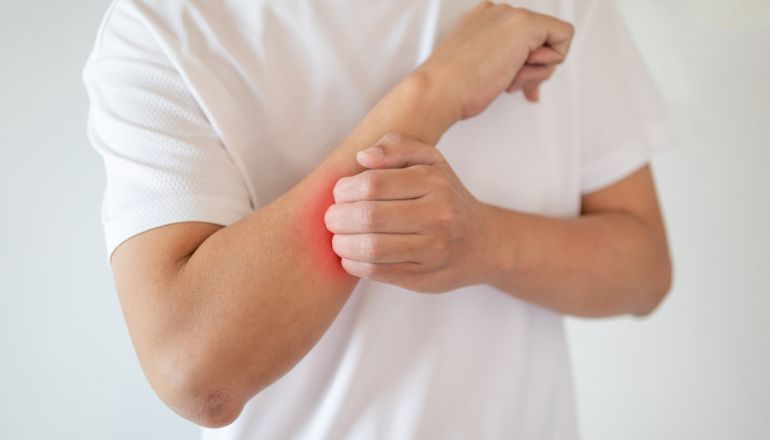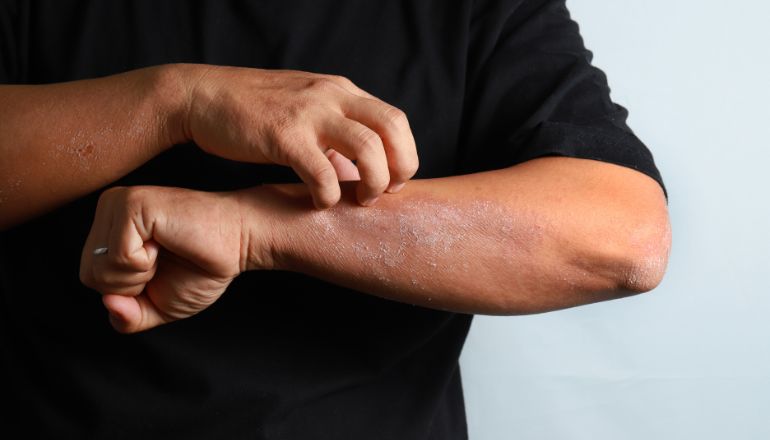Author: Dr.Steffy Mariyam Reji (Specialist Dermatologist – WELLKINS Medical Centre)
Dry skin is a widespread skin problem that often worsens during winter when environmental humidity is low. It can affect people of all ages, whether or not they have other skin issues. This common condition leads to small, fine flakes and dry patches, making the skin’s normally subtle lines more visible. The skin feels rough and appears dull and flaky. In advanced cases, fishnet-like cracks resembling the fine fracture lines of cracked porcelain can develop. While dry skin commonly affects the arms and legs, it can also impact the body’s trunk. Dermatologists often refer to dry skin as Asteatosis or Xerosis.
Dry skin very commonly produces itching, which can be severe and interfere with sleep and other daily activities. Repeated rubbing and scratching can produce areas of thickened, rough skin (lichenification). Dry, thickened skin can crack, especially in areas subject to chronic trauma (e.g., hands and feet), causing painful cracks in the skin (fissures). Dry skin and scratching may result in dermatitis when the skin becomes red (inflamed) in addition to dry and scaly. Round, scaly, itchy, red patches scattered over the legs, arms and trunk (nummular eczema) may also appear. The appearance of yellow crusts or pus in these areas indicates that a bacterial infection is developing. Severe dry skin is a feature of certain genetic diseases such as atopic dermatitis and ichthyosis (fish scale-like skin). In addition, people with hormone imbalances such as under activity of the thyroid gland can also experience severe skin dryness.

What causes dry skin?
The outermost layer of the skin called the stratum corneum, consists of dead skin cells embedded in a mixture of natural oils (lipids) that are made by underlying living skin cells. These natural skin oils keep the water inside our body from escaping into the air and also keep irritating substances and germs from entering the body. Both the skin oils and the dead skin cells hold a certain amount of water in the stratum corneum and it is this stratum corneum water that helps keep the skin soft, pliable and smooth.
Dry skin results when there is not enough water in the stratum corneum for it to function properly. One way this can happen is when protective oils in the stratum corneum are lost and the water that is normally present in the skin is allowed to escape. Too much soapy water, exposure to harsh chemicals, the normal aging process and certain types of skin diseases are some of the causes of decreased amounts of protective skin oils. As the stratum corneum dries out it shrinks and, as it shrinks, small cracks can occur. This exposes the underlying living cells to irritating substances and germs in the environment.

Essential Tips for Healthy, Hydrated Skin: Nutrition, Hydration, and Moisture Balance
Help maintain your moisture balance by applying a hydrating mask to your face and neck once a week, gently rubbing it in. After showering, use a moisturizing cream or lotion to restore moisture balance. Ensure thorough lubrication before bedtime. At night, a nourishing night cream can work wonders for healing your skin.
Proper nutrition is vital in combating dry skin, especially with the help of Vitamins A and B. Vitamin A can be found in fish, liver, fruit, milk, and eggs. Vitamin B is present in cereal products (bread), vegetables, and meat.
Every day, our bodies lose water, and it’s crucial to replenish it. Therefore, it is important to drink about 2 liters of water a day. For dry skin, incorporate foods like avocado, olive, citrus, kiwi, and cabbage into your diet. Avoid coffee, black tea, margarine, and fried foods.
Dry air exacerbates dry skin. Place a bowl of water on or near the radiator and regularly refill it so that water evaporates, moistening the air and preventing excessive moisture loss from your skin. Consider adding a humidifier to your home’s central heating system. If you use a portable humidifier, ensure it is placed in your bedroom at night.
Help maintain your moisture balance by applying a hydrating mask to your face and neck once a week, gently rubbing it in. After showering, use a moisturizing cream or lotion to restore moisture balance. Ensure thorough lubrication before bedtime. At night, a nourishing night cream can work wonders for healing your skin.
Effective Treatment and Management of Dry Skin

Treatment is to identify and tackle any factors that may be contributing to the dry skin. It is natural to think that applying water alone to dry skin would help control the problem. However, water alone (especially hot water) can actually worsen the problem of dry skin by removing the normal, protective skin oils. Hot, soapy water depletes the natural skin oils to the greatest degree. However, water followed by the application of oil such as a moisturizer or emollient or lubricant is of great benefit for dry skin. The oil in the moisturizer helps trap and seal water in the stratum corneum and makes the skin softer, smoother and less likely to become dry, cracked and itchy. A mainstay of management is attention to proper bathing techniques & use of moisturizers liberally. A short bath or shower (no more than 10 minutes) only once in a 24 hour period is advised.
For adults, showers are generally better than baths. While longer baths or showers, especially in hot water, can be quite relaxing, they will also increase the loss of natural oils from the skin and worsen skin dryness. The bath or shower should be in warm rather than hot water. Soap should be used minimally and only when and where needed (for example, under the arms, the groin and genitals, the feet, and the face). Milder, less drying soaps include Dove, Neutrogena Dry Skin Formula (unscented), Aveeno Cleansing Bar for Dry Skin is recommended. Cetaphil liquid cleanser works as a gentle and effective soap substitute for some people. It is especially helpful for cleaning the face and hands. After bathing or showering, quickly and gently pat the skin partially dry with a towel (do not rub!).
Within minutes of getting out of the water apply a moisturizer to seal the water in the skin before it can evaporate. Bath oil, if selected as a moisturizer, can be directly rubbed into the skin after showering or bathing. Moisturizers should be reapplied liberally during the day and evening when possible especially to those areas prone to dryness (hands, arms, legs) and when itchy. Treat any red dermatitis (eczematous) patches with a topical cortisone (steroid) cream or ointment for a week course. When using both a cortisone product , always use the moisturizer after applying the cortisone. Be careful about using other over-the-counter anti-inflammatory and itch-suppressing creams or lotions. Many of these products contain chemicals that can irritate or cause allergic reactions in dry, dermatitic skin. A good general rule is if anything that you apply to your skin causes more burning and itching than you started with, you should stop using it & consult a doctor. Use skin moisturizers (emollients) for long term control and prevention of dry skin. Dry skin is usually a long-term problem that recurs often, especially in winter. When you notice your skin beginning to get dry, resume your moisturizing routine and avoid the use of harsh soaps. If the itchy, dry skin remains then try to consult a doctor.






